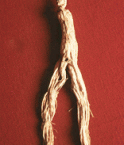Asian Ginseng

On this page:
Introduction
This fact sheet provides basic information about Asian ginseng—common names, what the science says, potential side effects and cautions, and resources for more information.
Asian ginseng is native to China and Korea and has been used in various systems of medicine for many centuries. Asian ginseng is one of several types of true ginseng (another is American ginseng, Panax quinquefolius). The herb called Siberian ginseng or eleuthero (Eleutherococcus senticosus) is not a true ginseng.
Treatment claims for Asian ginseng are numerous and include the use of the herb to support overall health and boost the immune system. Traditional and folk uses of ginseng include improving the health of people recovering from illness; increasing a sense of well-being and stamina; improving both mental and physical performance; treating erectile dysfunction, hepatitis C, and symptoms related to menopause; and lowering blood glucose and controlling blood pressure.
The root of Asian ginseng contains active chemical components called ginsenosides (or panaxosides) that are thought to be responsible for the herb’s claimed medicinal properties. The root is dried and used to make tablets or capsules, extracts, and teas, as well as creams or other preparations for external use.
What the Science Says
- Some studies have shown that Asian ginseng may lower blood glucose. Other studies indicate possible beneficial effects on immune function.
- Although Asian ginseng has been widely studied for a variety of uses, research results to date do not conclusively support health claims associated with the herb. Only a few large, high-quality clinical trials have been conducted. Most evidence is preliminary—i.e., based on laboratory research or small clinical trials.
- NCCAM supports studies to better understand the use of Asian ginseng. Areas of recent NCCAM-funded research include the herb’s potential role in treating insulin resistance, cancer, and Alzheimer’s disease.
Side Effects and Cautions
- Short-term use of ginseng at recommended doses appears to be safe for most people. Some sources suggest that prolonged use might cause side effects.
- The most common side effects are headaches and sleep and gastrointestinal problems.
- Asian ginseng can cause allergic reactions.
- There have been reports of breast tenderness, menstrual irregularities, and high blood pressure associated with Asian ginseng products, but these products’ components were not analyzed, so effects may have been due to another herb or drug in the product.
- Asian ginseng may lower levels of blood sugar; this effect may be seen more in people with diabetes. Therefore, people with diabetes should use extra caution with Asian ginseng, especially if they are using medicines to lower blood sugar or taking other herbs, such as bitter melon and fenugreek, that are also thought to lower blood sugar.
- Tell all your health care providers about any complementary health practices you use. Give them a full picture of what you do to manage your health. This will help ensure coordinated and safe care. For tips about talking with your health care providers about complementary and alternative medicine, see NCCAM's Time to Talk campaign.
Search the scientific literature for potential herb-drug interactions
Sources
- Ginseng. Natural Standard Database Web site. Accessed at www.naturalstandard.com on May 7, 2009.
- Ginseng, Panax. Natural Medicines Comprehensive Database Web site. Accessed at www.naturaldatabase.com on May 7, 2009.
- Ginseng root. In: Blumenthal M, Goldberg A, Brinckman J, eds. Herbal Medicine: Expanded Commission E Monographs. Newton, MA: Lippincott Williams & Wilkins; 2000:170–177.
- Soldati, F. Ginseng, Asian (Panax ginseng). In: Coates P, Blackman M, Cragg G, et al., eds. Encyclopedia of Dietary Supplements. New York, NY: Marcel Dekker; 2005:265–277.
For More Information
NCCAM Clearinghouse
The NCCAM Clearinghouse provides information on NCCAM and complementary health approaches, including publications and searches of Federal databases of scientific and medical literature. The Clearinghouse does not provide medical advice, treatment recommendations, or referrals to practitioners.
PubMed®
A service of the National Library of Medicine (NLM), PubMed® contains publication information and (in most cases) brief summaries of articles from scientific and medical journals.
Office of Dietary Supplements (ODS), National Institutes of Health (NIH)
ODS seeks to strengthen knowledge and understanding of dietary supplements by evaluating scientific information, supporting research, sharing research results, and educating the public. Its resources include publications (such as Dietary Supplements: What You Need to Know), fact sheets on a variety of specific supplement ingredients and products (such as vitamin D and multivitamin/mineral supplements), and the PubMed® Dietary Supplement Subset.
NIH National Library of Medicine's MedlinePlus
This publication is not copyrighted and is in the public domain. Duplication is encouraged.
* Note: PDF files require a viewer such as the free Adobe Reader.
